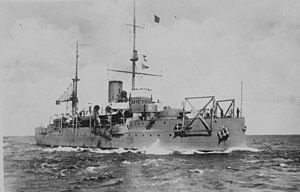HNLMS Hertog Hendrik
 Hertog Hendrik
| |
| History | |
|---|---|
| Name | Hertog Hendrik |
| Namesake | Duke Henry of Mecklenburg-Schwerin |
| Builder | Rijkswerf in Amsterdam |
| Laid down | 8 March 1901 |
| Launched | 7 June 1902 |
| Commissioned | 5 January 1904 |
| Recommissioned | 21 October 1947 |
| Decommissioned | 27 September 1968 |
| Renamed |
|
| Reclassified |
|
| Stricken | 28 August 1969 |
| Fate | Scrapped |
| Name | Ariadne |
| Namesake | Ariadne |
| Acquired | 14 May 1940 |
| Commissioned | 1943 |
| Reclassified | Anti-aircraft battery, 1943 |
| Fate | Handed back to the Netherlands after VE Day |
| General characteristics | |
| Class and type | Koningin Regentes-class coastal defence ship |
| Displacement | 5,002 tons |
| Length | 96.622 m (317 ft 0 in) |
| Beam | 15.189 m (49 ft 10 in) |
| Draught | 5.817 m (19 ft 1 in) |
| Installed power | 6,500 ihp (4,800 kW) |
| Propulsion | 2 shafts, 2 reciprocating engines |
| Speed | 16.5 knots (30.6 km/h; 19.0 mph) |
| Complement | 340 |
| Sensors and processing systems |
|
| Armament |
|
| Armour |
|
HNLMS Hertog Hendrik (
Design
The ship was 96.622 meters (317 ft) long, had a
Service history
Hertog Hendrik was laid down on 8 March 1901 by the Dutch Queen Mother,
The ship was launched and christened there by, Prince Henry on 7 June 1902. She was commissioned into the Royal Netherlands Navy on 5 January 1904 and the first ship in the Dutch navy to be equipped with wireless communication. The ship left Den Helder on 9 November 1904 for the Dutch East Indies. Shortly after she had departed she send the first Dutch wireless telegram.[3]
On 24 June 1905 Hertog Hendrik hit a
During the second expedition on 11 September De Ruyter, Hertog Hendrik,
In 1910 the ship together with the cruiser Holland escorted another cruiser, Noordbrabant, that had hit a cliff on 31 May while en route to Surabaya. The collision caused the flooding of several compartment of the ship. Damaged as she was, Noordbrabant continued to sail without aid.
Later that year the ship undertook a cruise to Australia to show the flag. After leaving Surabaya on 15 August 1910, Hertog Hendrik and both her sister ships, De Ruyter and Koningin Regentes, visited the ports of Brisbane, Melbourne, Sydney, Fremantle and several others.[5]
Hertog Hendrik and Noordam deployed as auxiliary cruiser left the Netherlands on 16 February 1918 as convoy to the Dutch East Indies. They planned to take the route through the Panama Canal. North of Scotland the ships encountered a heavy storm and were forced to return to make necessary repairs. The ships arrived on 19 March in Den Helder. On 5 July that year a second attempt was made to reach the Dutch East Indies by going around Scotland and Cape of Good Hope. This time the convoy consisted of Hertog Hendrik, Tabanan deployed as auxiliary cruiser, Bengkalis deployed as coaling ship and Noordam. The convoy reached Tanjung Priok, Dutch East Indies on 27 September that year.[6]

On 2 March 1920 she and
On 27 March 1934 the ship entered the harbor of Den Helder. The ship and crew had just returned from gunnery practice during the first three months of 1934 in the Mediterranean Sea and 19 February the ship had made an official visit to Venice. Later that year during the Open Day of the Navy in Scheveningen the ship and crew gave a demonstration with searchlights.[8]
During the Spanish Civil War she performed convoy duties.[9]
World War II
In 1939 December the ship served as floating battery ship Batterijschip Vliereede off Vlieland for several weeks. In early 1940 she was laid up waiting to be scrapped. However the floating hulk was on captured on 14 May 1940 by the invading German forces. The ship sank after being attacked by a British aircraft on 21 and 22 June 1940. The Germans decided to salvage her in October 1940 and converted her into an Anti Aircraft battery at Antwerp. The conversion lasted from 1941 to 1943 and the ship was renamed Ariadne. After the war the ship was recovered in Wilhelmshaven and given back to the Netherlands, to be converted at the Wilton-Fijenoord shipyard into an accommodation ship. On 21 October 1947 she was recommissioned and given back her initial name Hertog Hendrik. She was finally decommissioned on 27 September 1968 and stricken from the navy list on 28 August 1969.[10]
References
- ^ "scheepvaartmuseum.nl :: Maritieme kalender 1901". Retrieved 23 April 2013.
- ^ "scheepvaartmuseum.nl :: Maritieme kalender 1904". Retrieved 23 April 2013.
- ^ "scheepvaartmuseum.nl :: Maritieme kalender 1905". Retrieved 23 April 2013.
- ^ "scheepvaartmuseum.nl :: Maritieme kalender 1910". Retrieved 23 April 2013.
- ^ "scheepvaartmuseum.nl :: Maritieme kalender 1918". Retrieved 25 April 2013.
- ^ "scheepvaartmuseum.nl :: Maritieme kalender 1920". Retrieved 23 April 2013.
- ^ "scheepvaartmuseum.nl :: Maritieme kalender 1934". Retrieved 24 April 2013.
- ^ "scheepvaartmuseum.nl :: Maritieme kalender 1938". Retrieved 23 April 2013.
